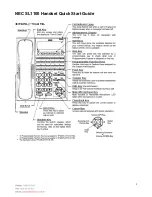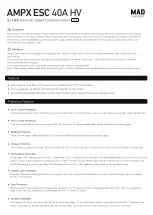
1
• Do not back up the motorhome with the towed ve
-
hicle attached.
Backing up with the towed vehicle attached will
cause the towed vehicle to “jackknife,” which will dam
-
age the tow bar, the mounting bracket, the receiver
hitch, the towed vehicle’s front end, and/or the rear
of the motorhome. Backing up with the towed vehicle
attached is the primary cause of tow bar damage and
will void the warranty.
• Be sure the vehicle can be towed
before taking it on
the road. Some vehicles must be equipped with a transmis-
sion lube pump, an axle disconnect, driveline disconnect
or free-wheeling hubs before they can be towed. Failure
to properly equip the vehicle will cause severe damage
to the transmission.
Check the vehicle manufacturer’s instructions for the
proper procedure(s) to prepare the vehicle for towing.
• The tow bar must be within the ‘Safe Zone’
— no
more than three inches above or below level. Towing with
an out-of-level tow bar will cause significant wear and tear
on the tow bar and mounting brackets, and on the towed
vehicle’s suspension and frame. (See the section titled
“Stay within the ‘Safe Zone’” for further information.)
• The steering wheel must be unlocked and free to
turn when towing.
Failure to do so can cause severe
tire and equipment damage. Check the manufacturer’s
instructions for the proper towing procedure(s).
• The towed vehicle and all its contents cannot ex
-
ceed 6,000 pounds.
The Sterling All Terrain
tow bar is
rated at a maximum of 6,000 pounds carrying capacity;
therefore the towed vehicle and all its contents cannot
exceed 6,000 pounds.
In addition, the receiver hitch, the safety cables, and
all supplementary towing equipment must be rated at no
less than the weight of the towed vehicle and all its con-
tents.
• The tow bar must be secured with linch pins (or
optional padlocks) before towing.
Unless the tow bar
is secured to both vehicles with all appropriate pins (or
padlocks), the towed vehicle will detach.
• Inspect the system before towing
— check the mounts,
brackets, fasteners, bolts, wiring, the safety cables and all
other components each time before towing.
Additionally, check the tow bar bracket every 3,000
miles — inspect for any fractures or cracks in the steel, or
any visible damage. Do not tow if the tow bar bracket is
damaged.
Additionally, check the torque on all bolts. (To find
the torque ratings, refer to the installation instructions for
the mounting bracket and the tow bar.)
• Never tow a vehicle with one of a comparable
weight.
The towed vehicle’s weight should never exceed
40 percent of the towing vehicle’s weight.
Towing a vehicle with one of similar weight will cause
the towed vehicle to override the towing vehicle, result-
SAFE TOWING PRACTICES
ing in “jackknifing,” “leapfrogging” or “fishtailing.” Serious
damage to both vehicles, as well as the towing system,
could result.
• Always stand to one side and as close to the motor-
home as possible when releasing the tow bar locking
mechanisms.
Never stand between the adjustable arms,
or put any part of your body between the adjustable arms,
when releasing the tow bar — always stand to one side.
Because the towed vehicle may jerk forward when the
locking mechanisms are released, face the towed vehicle
and stand as close to the back of the motorhome as pos-
sible before releasing the locking mechanisms, to keep
from being hit by the towed vehicle.
• Always use safety cables when towing.
The safety
cables, which are provided with the Sterling All Terrain,
must connect the towed vehicle to the towing vehicle frame
to frame.
If the safety cables are ever replaced, use only 6,000
pound or heavier rated safety cables.
Additionally, check to ensure that the safety cables are
the proper length. Refer to the sections titled “How to use
safety cables” and “Proper installation of safety cables”
for further information.
• Check the motorhome turning radius.
Some motor-
home chassis have such a tight turning radius that you
can damage your motorhome, towed vehicle, or tow bar
while turning too sharply. Before getting on the road with
your towed vehicle, you should test your turning radius in
an empty parking lot.
With the towed vehicle attached, have someone watch
as you slowly turn sharply to see whether you have this
potential problem. If you do, note how far you can safely
turn the motorhome’s steering wheel, and be sure not
to turn it further when towing. Damage that results from
turning too sharply is not covered by warranty.
• Never use the tow bar to tow more than one vehicle.
In some states it is legal to have one vehicle towing more
than just one vehicle (for example, a truck which is towing
a trailer which is towing a boat). However, when using a
tow bar, never tow more than one vehicle, or non-warranty
damage or injury may result.
• The tow bar stinger fits motorhome hitch receivers
with two-inch inner diameters.
If the motorhome hitch
receiver is a larger size, attach a two-inch adaptor sleeve
(not supplied) to the hitch receiver.
Damage to the tow bar stinger or other components of
the tow bar, abnormal wear patterns on the towed vehicle’s
tires, as well as other, consequential damage may result
if an adaptor sleeve is not used.
• Keep the tow bar clean and well-lubricated.
As is
the case with most precision equipment, frequent clean-
ing and care results in better performance and longevity.
Refer to the section titled “Care and cleaning” for further
information.
Failure to follow these instructions may cause prop-
erty damage, personal injury or even death.


































